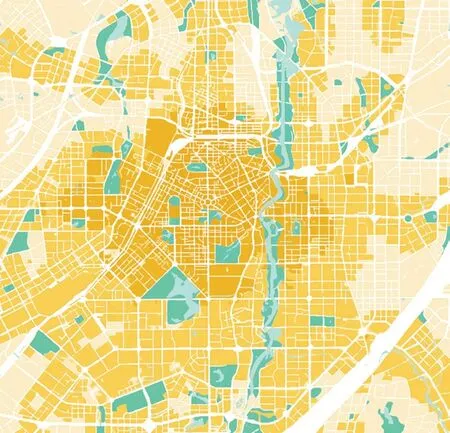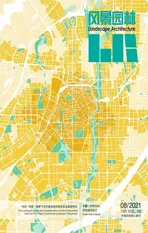面向绿色发展的城市设计
2021-08-24郑曦

古代很多城市的形态都呈现出规则的设计特征,中国的西周洛邑、隋唐长安城、南宋临安、明清北京城,西方的古希腊米利都城、古罗马提姆加德城……而早期城市的理论模型也呈现出规整的风貌:中国以《周礼·考工记》中“方九里,旁三门,九经九纬,左祖右社,前朝后寝”的型制为代表,西方维特鲁威的《建筑十书》则是在古希腊早期设想的基础上提出理想城市模型——八角形平面和放射环形路网,对文艺复兴后期的城市形态产生了一定影响。在这些规则的城市外围,往往都是自然的山野、丛林、农田和溪流,城市与周围的自然系统之间呈现出清晰的秩序和相互融合的关系。
工业革命带来的大生产导致城市中劳动力短缺,人们纷纷从农村涌入城市。城市原本的规模难以承载激增的人口,产生了住房短缺、交通拥挤、环境恶化等一系列问题,社会改革的呼声日益高涨。英国开始兴建城市公园,建设下水道、环卫等城市基础设施,极大改善了城市环境和风貌。伴随工业革命推进到法国,巴黎进行改扩建规划,对道路、住房、市政建设和土地经营等做了全面的安排,城市园林第一次被纳入城市公共设施建设工程范畴;科隆、维也纳等城市也纷纷效法巴黎,对城市进行改造。在朗方的华盛顿方案中能看到凡尔赛宫苑的影子。格里芬在设计澳大利亚首都堪培拉时,像设计园林一样设计城市,把城市主体空间让位于自然山水。1893年,芝加哥举办了世界博览会,利用湖滨地带在会场兴建了林荫大道和优美的游憩场地,使人们认识到美化城市景观和解决城市脏乱问题的重要性,因而在美国掀起了“城市美化运动”的热潮,并逐步将城市公园建设与城市设计联系起来。在这一时期,绿色空间始终是粘合剂,弥补城市建设、工业生产与社会发展、人民需求之间的裂痕。
现代“城市设计”概念在20世纪中叶由哈佛大学提出,中国在1980年正式提出“城市设计”。虽然概念出现较晚,但是人类关于城市设计的经验和智慧孕育于社会发展进程之中。城市设计是社会发展分工细化后的结果,作为综合多学科的媒介,促进城市建设过程中的多方合作。随着生态学逐渐发展成为一门独立的学科,蕾切尔·卡逊、伊恩·麦克哈格等人把生态的理念引入了城市设计,人们越发关注城市的可持续性和韧性。近些年,被广泛探讨的景观都市主义、生态都市主义等城市设计构想都将生态作为城市发展的基本驱动。
在生态文明时代,“绿色”具有更多内涵与外延,融入降低能耗、减碳、碳中和等理念,并逐渐与城市设计接轨。21世纪初,许多欧洲城市把绿色城市设计付诸实践。瑞典的马尔默Bo01新城和斯德哥尔摩Hammarby新城探索建立面向未来的生态城市,拥有较高密度、适合步行和骑行的社区,拥有超低能耗房屋、低碳交通设施,人均温室气体排放量维持较低水平。但在更好地与景观融合方面仍有欠缺,称得上是良好的建筑节能解决方案,但不能说是绿色城市设计典范。正如建筑师迈克尔·丹尼斯(Michael Dennis)所认为的:“生态可以整合到紧凑的发展中,密度并不排除生态考虑;生态和密度是异卵双胞胎。”生态系统可以与高密度、紧凑的人性化社区形式相结合,绿色城市设计需要在城市形式、建筑、景观和人之间建立紧密融合的最佳路径。
当前中国很多城市都致力于建设低碳城市、未来城市,举办极具吸引力的国际城市设计竞赛,经常会在媒体上看到非常震撼的城市设计竞赛获奖作品,我们需要追踪这些方案后续有多少能够最终落地?更需要关注的是城市设计会不会沦为仅为了竞赛而做的图纸和文案,是否能够作为切实指导城市发展建设的有效手段。任何时代的城市设计与建设,都以满足人民的美好生活需求为根本。城市是服务于人的需求的,随着时代变化,人们对于美好生活的需求一直在变,不变的是人类建设理想居住环境的不断探索和努力。

Urban Design for Green Development
Many ancient cities, such as Luoyi (today’s Luoyang City) in the Western Zhou Dynasty, Chang’an City in the Sui and Tang Dynasties, Lin’an in the Southern Song Dynasty, Beijing in the Ming and Qing Dynasties, Miletus in ancient Greece and Timgad in ancient Rome, presented regular design features. The theoretical model of early cities also showed a regular style. For example,in China, as stated in the book of Zhou Li·Kaogongji, most imperial cities have been built with a “square of nine Li (a Chinese unit of length), three gates on each side, nine north-south roads and nine east-west roads in the cities. On the left of the palace city was the ancestral temple, on the right was the state altar, in the front was the court hall, and at the behind was the chamber”.In the West, the Ten Books on Architecture (de architectura libri decem) by Vitruvius put forward an ideal city model based on the early ideas of ancient Greece, characterized by an octagonal plane and radial ring road network, which, to some extent, influenced the form of cities in the late Renaissance period. Outside these regular cities often lie natural mountains, jungles, farmland and streams.The cities and the surrounding natural systems presented a clear order and integrated relationship.
However, the mass production brought about by the industrial revolution led to a shortage of labor in cities, causing a people rush from the countryside into the cities. The cities,with their original scales, failed to accommodate the surging population, resulting in a series of social problems, including housing shortage, traffic congestion and environmental deterioration, and the call for a social reform was rising day by day. After that, the Great Britain started to build city parks and urban infrastructures such as sewers and environmental sanitation, which greatly improved the urban environment and appearance. With the promotion of the industrial revolution into France, Paris implemented a reconstruction and expansion plan. In this plan, comprehensive arrangements were made for roads, housing, municipal construction and land management,and city gardens for the first time were included in the scope of urban public facilities construction projects. Besides, Cologne,Vienna and many other cities also followed Paris to reconstruct their cities. That’s why we can see the influence of Versailles’gardens in L’Enfant’s plan proposal for Washington. When designing Canberra, the capital of Australia, Griffin designed the city as if he was designing a garden, giving priority to the natural landscape over the main urban space. In 1893, Chicago hosted a World Expo where the lakeside area was built into a boulevard and beautiful recreational site, which made people recognize the importance of beautifying the city landscape and solving the problem of city mess. Therefore, an upsurge of “City Beautiful Movement” was set off in the United States, and gradually the construction of city parks was integrated into urban design.During this period, green space was all along the adhesive in making up for the gap between urban construction & industrial production and social development & people’s needs.
The concept of modern “urban design” was put forward by Harvard University in the middle 20th century. In China, the concept was officially put forward in 1980. Although the concept was put forward late, the human experience and wisdom on urban design has been nurtured in the process of social development.Urban design is a result of labor division in the social development.As a comprehensive multi-disciplinary medium, urban design has promoted multi-party cooperation in the process of urban construction. As ecology has been gradually developed into an independent discipline, Rachel Carson and Ian McHarg et, al. have introduced the concept of ecology into urban design, and people are focusing more and more on the sustainability and resilience of cities. All the urban design ideas widely discussed in recent years,such as landscape urbanism and ecological urbanism, have taken ecology as the basic driving force for urban development.
In the era of ecological civilization, “green” has more complex connotation and denotation. It has been integrated with the concepts of energy consumption reduction, carbon emission reduction and carbon neutralization and was gradually integrated into urban design. At the beginning of the 21st century, many European cities have put green urban design into practice. The Bo01 City of Tomorrow in Malmo and the Hammarby new city in Stockholm, Sweden explored the construction of futureoriented ecological cities which featured high-density communities suitable for walking and cycling, ultra-low energy consumption houses and low-carbon transportation facilities, as well as lowlevel per capita greenhouse gas emission. However, there is still room for improvement in the integration with the landscape. The city plans are good energy-saving building plans, but cannot be regarded as good models of green urban design. Ecology can be integrated into compact urban development. As the architect Michael Dennis once said, “Density does not exclude ecological considerations. On the contrary, ecology and density are fraternal twins.” Hence, ecosystem can be integrated with high-density and compact humanized communities, and green urban design needs to find the best path for close integration among the city form,architecture, landscape and human.
Many cities in China have committed themselves to building low-carbon cities or future cities and holding attractive international urban design competitions. Often, we see very amazing award-winning works in urban design competitions from the media, but how many of these works can be subsequently implemented? Will urban design be reduced to drawings and copywritings just for competition, and whether can these drawings and copywritings be used as effective means to guide urban development and construction? I believe that urban design and construction in any era are based on the satisfaction of human needs for a better life. Cities serve people’s needs. As the times change, people’s needs for a better life change too. What remains unchanged is the continuous exploration and efforts that human beings have made and will continue to make to build an ideal living environment.
Editor-in-Chief: Professor ZHENG Xi
July 25, 2021
